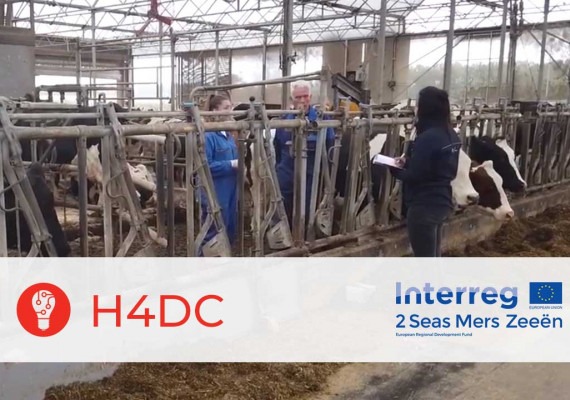H4DC
Health for Dairy Cows
Priority Axis
Technological and Social InnovationSpecific objective
Technological Innovation
Lead partner
JuniaContact
Start Date
01/03/2019End Date
31/03/2023Project budget
3 786 582 €ERDF amount
2 271 949 €ERDF rate
60%About
Common challenge
Animal diseases such as Cryptosporidiosis can also pose a threat to human health. Human outbreaks can occur from water collected in areas contaminated by bovine stools. In cattle farms, this common illness is difficult to control without good breeding practices, efficient detection tools or effective pharmaceuticals. Young, infected animals spread millions of parasites a day and show stunted growth. This disease leads to a higher mortality rate, which further threaten the economic viability of a sector which already faces frequent crises. By reducing the impact of cryptosporidiosis in farms, H4DC aimed to increase farm productivity in a number of different countries, making these businesses more efficient and successful, with a lower impact on human health. For this purpose, the project sought to provide pilot farms, detection tools and technological devices that can accelerate the discovery of new drugs at the lowest possible cost. No vaccine or drug was available in Europe for animal or human treatment. The molecules with antiparasitic effects have been proven toxic for younglings. Finding new molecules has been hindered by the lack of automated and standardized tools that can study the drug’s impact on a complete parasite’s life cycle.
Overall objective
Main outputs
Cross border approach
Main Achievements
The H4DC consortium was able to successfully complete the project and achieve the objectives and results that were initially planned. 20 farms in France, 17 farms in Belgium and 20 farms in the Netherlands were recruited. Three sampling campaigns were done and enabled the presence of Cryptosporidium parasite population (leading to 2 scientific articles and 2 presentations in international scientific conferences). Following an analysis of the scientific literature on the risk factors leading to the dissemination of the parasite in herds, partners were able to advise breeders on changes to their practices, and 2 years later they evaluated the benefits for breeders. To build a test kit, a set of Cryptosporidium parasite proteins was synthesized. Antibodies targeting these molecules were generated and used in new test strips.
The H4DC partnership was also able to build and test a drug screening device associated with a complete set up to analyse and record electric responses of cells when infected by parasites. The development of an Artificial intelligence software and the specific training of a neuronal based network accelerated microscopic observation used to assess drug efficiency and automated a process that was initially carried out manually. This approach is now being used to test additives supplied by a private company. Two biopharmaceutical companies have expressed interest in accessing these technologies to carry out tests for their own anti-parasitic drugs.
Dissemination of the project was impeded by travel restriction during covid lockdown, but H4DC partners were able to create a wide range of contacts (Farmers, Veterinarians, Biotechnological/Biopharmaceutical companies). Since September 2022, one codirected PhD project has been launched between partners UK & France. This will guarantee the continuation of the project beyond its closing date. Two market studies and two business models have been done. Additionally, during the H4DC project, samples collected in farms were also used to study the impact of the metabolome changes due to parasite infection. The genetic analysis of calves was also done to detect if specific genes could represent parasite contamination risk factors. Such results are essential for genetic selection and could have an important economic impact for breeders.
Testimonial
“The implementation of breeding strategies to reduce the impact of diarrhea in dairy calf populations is one of the most notable changes achieved thanks to the H4DC project. This has halved the number of sick or dead calves.”

